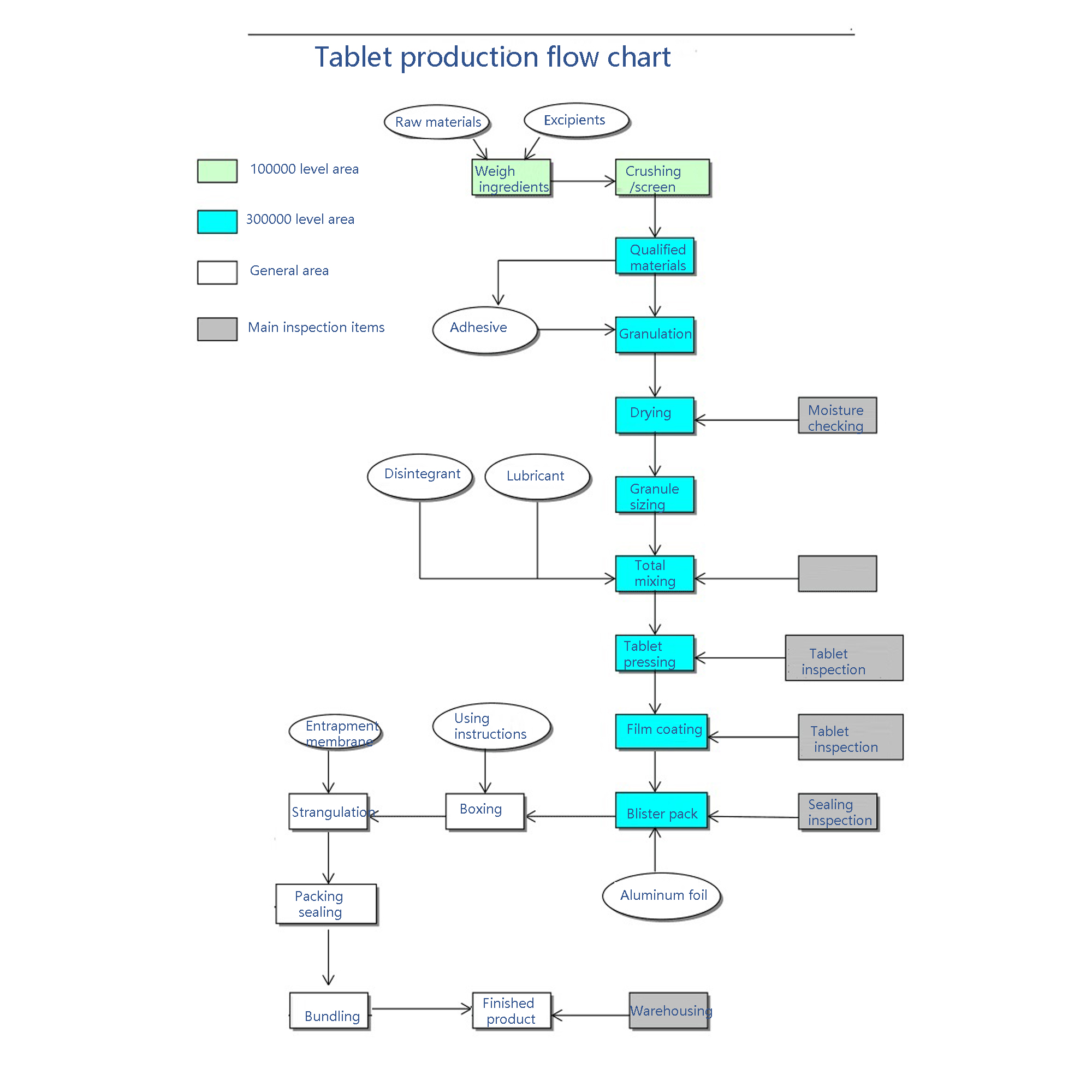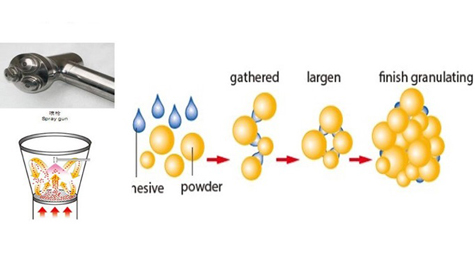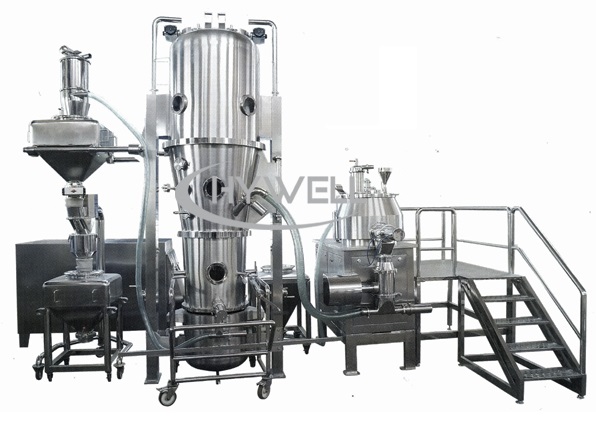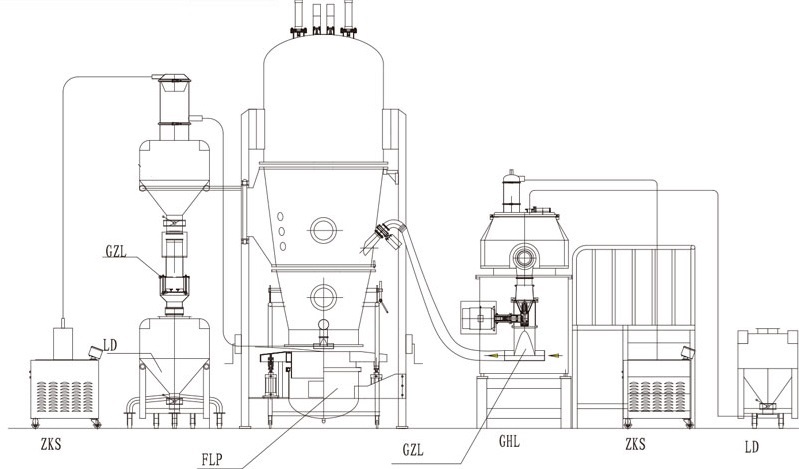Views: 11 Author: Site Editor Publish Time: 2023-11-08 Origin: Site
Tablets refer to tablet preparations made of drugs, and appropriate excipients through preparation technology. Tablet composition: original drug, filler, adsorbent, binder, lubricant, dispersant, wetting agent, disintegrant, flavoring, Color materials, and other components.
Tablets are the preferred and most widely used dosage form in the development of new drugs. The manufacturing process of tablets includes API pretreatment, dosing, granulation, tablet pressing, coating, and other processes. Among them, the granulation process plays a very important role in the whole tablet production, which is of great significance to prevent possible problems in the production process of tablet pressing and ensure the quality of drugs. For example, if the amount of binder added in the granulation process is too small and the granules are too dry, it will lead to lobes in the process of tablet pressing; if the granules are too wet, it will lead to sticky punch, astringent punch, uneven granules, and if the granules are too hard, it will also affect the dissolution and so on. Therefore, mastering the key points of the granulation process is a mandatory course for drug developers.

Powder Granulation processes include the following main categories.
- Wet granulation (Commonly used representative equipment is high shear granulator): material + binder - wet granules - drying.
- Dry granulation (Commonly used representative equipment is roller compactor granulator): heat-sensitive materials - rolled into flakes - broken into granules
- Fluidized bed granulation (Commonly used representative equipment is fluidized bed dryer granulator): material fluidization + binder atomization- drying - granulation
- Spray granulation (Commonly used representative equipment is spray granulator): material + binder into the solution - spray drying.
This article mainly wants to discuss with you the fluidized bed granulation process. Fluidized bed granulation is the mixing of raw materials, granulation, drying, and other processes that are concentrated in the fluidized bed spray granulator to complete the granulation task efficiently.
The principle of granulation is rough as follows: the raw and ingredients materials into the closed fluidized bed, and fluidization is to achieve powder mixing. Spray the gun in the conditions of atomization pressure and injection speed, and then spray the liquid into the raw material powder and gather the atomized droplets form around nuclear particles, continuous injection of liquid droplets in particle nuclear surface forms a liquid bridge, between the particles and particle nuclei together to promote the particles grew up continuously, after drying of liquid bridge between evaporation further solid bridge formation, namely porous particles get round shape; With the increase of liquid saturation, the particle size gradually increases, and the porosity further decreases. this is also a fluid bed spray granulator working principle.

Fluidized bed equipment is mainly composed of dehumidification (Optional), a Primary filter, an Intermediate filter, a high-temperature high-efficiency filter(H13 ), a heater with accurate temperature control, a bottom bowl, a movable product bowl with a trolley, a fluidized chamber, expansion chamber/filter housing, spraying system and exhaust air system. Its structure from top to bottom can be divided into three parts of the cylinder: the uppermost cylinder will generally be installed inside the filter bag, mainly for vibration dust removal; the middle cylinder is a cylindrical expansion chamber, the material in the upward airflow and downward gravity in the material tank and expansion chamber reciprocal movement, particles suspended in the hot dry air to form a better fluidization state; the lower cylinder is the charging tank, the material is thus added. There are many advantages of fluidized bed one-step granulation, such as the mixing, granulation, and drying of materials being completed in the same fluidized bed equipment, reducing a large number of operational links, saving production time; suitable process parameters within the range of the resulting particles of uniform size, round, fluidity, and good compressibility; equipment closed to effectively avoid the flying of a fine powder, not only to prevent external pollution of drugs, but also to reduce the number of operators with It can not only prevent the outside contamination of the drug but also reduce the chance of contact between the operator and irritating or toxic drugs and excipients, which is more in line with the GMP requirements; high degree of automation, easy to enlarge and reproduce.

The inlet air temperature of fluid bed granulation should be controlled within the appropriate range according to the nature of the material and the size of the particles required. If the solvent of the binder is an organic solvent such as ethanol, the inlet air temperature should be slightly lower than that of a solvent such as water. In the case of other parameters remaining unchanged, if the inlet air temperature is too high, it can lead to premature drying and evaporation of the sprayed adhesive droplets, reducing the wettability and permeability of the material, forming a liquid bridge and reducing the cohesion, thus affecting the aggregation ability of the particles, forming particles of smaller size, while the temperature is too high may also cause changes in the nature of some temperature-sensitive materials. The inlet air temperature is too low, which will lead to excessive wetting of the powder, and some of the material powder will agglomerate into clusters with each other and adhere to the wall of the vessel cant maintain a better fluidization state, which is more likely to cause cant fluid. Specific temperature settings are set according to different materials and processes.
The selection of the inlet air velocity in fluidized bed one-step granulation technology is based on the principle that the fluidized bed particles are always in a good fluidization state. The good fluidization state depends mainly on the moisture and weight of the material. In the process of fluidized bed one-step granulation, the state of the material changes from dry powder state to wet particles and then to dry particles, the fan speed needs to be adjusted constantly to ensure a good state of granulation by speed control inverter. When the slurry is granulated, the fan frequency can be increased moderately with the gradual increase in particle humidity; suitable air volume can make the material in a good fluidization state, and heat exchange in a balanced state, conducive to granulation. If the wind speed is too large, the material may be too blown to the dust bag, and too much hot airflow through the unit time, making the binder moisture volatilization too fast, the bonding force is weakened, while the binder droplets can not be fully contacted with the material so that the particle size distribution is a wide, more fine powder; and with the increase in wind speed, the particles are subjected to excessive impact force leading to too much abrasion of the particles.
spray liquid pressure is a non-negligible factor affecting the quality of granulation. Spray pressure is the process of highly dispersing the binder into atomized droplets by airflow. Generally speaking, the size of the spray pressure is inversely related to the final particle size. The larger the spray pressure, the smaller the atomized droplets, the larger the specific surface area of the droplets, and the faster the rate of evaporation of water by hot air, making the particle size smaller; conversely, the smaller the spray pressure, the larger the droplets formed, the larger the droplets may be more likely to produce larger clumps of particles, and the ability to wet the powder is further reduced. Therefore, the choice of atomization pressure should be made according to the material and instrument performance to make an appropriate choice. The pressure of the spray nozzle is adjusted by the control cabinet to adjust the compressed air pressure to adjust the spray pressure.
The selection of the spray flow rate is also directly related to the particle size. The spray flow rate is proportional to the size of the particle size, in the case of certain spray pressure, with the increase in spray speed, the atomized droplet size of the adhesive also increases, if the flow rate is too high, resulting in excessive humidity in the machine, the moisture on the surface of the wet particles can not be dried in time can lead to aggregation or adhesion into a group, the particle size of the particles thus become larger, more serious cases may lead to collapse of the bed; conversely, when the flow rate is too low, the particle size may be further reduced, too much fine powder, running a certain time may also cause the gun clogging, greatly limiting the efficiency. The following literature examines the spray rate and concludes that when the spray pressure and inlet air temperature/material temperature are constant, the highest particle qualification rate is obtained at a spray rate of 10 mL/min.
In summary, the factors affecting the particle size are summarized as follows: In the granulation process, the actual situation of the field granulation should be combined with a comprehensive adjustment of the influencing factors to control the particle size in the appropriate range.
Particle size | Inlet air volume | Inlet air temperature | Spray liquid pressure | spraying rate | Binder concentration | |||||
Big | Small | Big | Small | Big | Small | Big | Small | Big | Small | |
Small | Big | Small | Big | Small | Big | Big | Small | Big | Small | |
In addition to the above parameters, there are also factors that may affect the quality of granulation, including fluidized bed device airtightness and filter bag integrity check, binder concentration, gun height, material temperature, air inlet system, ducts are too dirty to cause black spots and so on. Fluidized bed granulation is a dynamic process, in the granulation process we need to observe the state of fluidization of the material in real-time, and timely adjust parameters to ensure that the quality of our granules is made in a good state, so that the subsequent compression or coating, etc.


Adjust the air inlet volume to make the materials in the container boil and fully mixed, and the boiling layer will not easily exceed the nozzle. The initial air volume of fluid bed dry granulator should not be too large, otherwise the powder will boil too high and adhere to the surface of the filter bag, causing air flow obstruction. When adjusting the air volume, it is better that the inlet air volume is slightly larger than the exhaust air volume. Generally, after the air volume is determined, you only need to adjust the exhaust air volume to achieve a suitable boiling state. When starting the fan, the damper needs to be closed. After the fan is running, the exhaust damper can be gradually increased to create an ideal material boiling state.
If the inlet air temperature of fluid bed granulation is too high, the particle size will be reduced, and if it is too low, the material will be over-wetted and form agglomerates. Therefore, it is very important to control the temperature during boiling granulation.
Steam enters the heater, causing the air to be heated as it passes through. Since the temperature rises and falls over a certain period of time when the steam is heated, it is necessary to pay attention to advance control and prediction when setting and adjusting. Personal experience, when using production equipment, when steam heating is heating up, there will be a buffer zone of about ten degrees, that is, the set temperature is 60°C, the temperature may rise to 70°C, and then gradually decrease and stabilize to 60°C, then if it is during the granulation process To adjust the temperature, you need to turn off the air inlet briefly in advance, or set the temperature about 10°C lower than the ideal temperature, and then adjust after it is relatively balanced.
When the temperature reaches the requirements, spray granulation can be carried out. At this time, the flow and pressure of the compressed air and the flow and velocity of the adhesive should be controlled. At the same time, the backflushing (blow-up) function of the filter bag needs to be turned on. Blowback every few seconds.
The bed pressure fluctuation is generally within ±3%. If the pressure fluctuation exceeds ±10%, the fluidization may not be ideal.
The flow rate and pressure of the compressed air and the flow rate and flow rate of the adhesive need to be appropriate to ensure the appropriate particle size distribution of the product.
During the spraying process, the material temperature and air outlet temperature drop. When they drop to a certain value, the spraying should be stopped to prevent wall sticking or sedimentation. When the temperature of the material returns to the original value, spraying begins again, and this cycle is repeated until the adhesive is sprayed out. It is necessary to pay attention to the maximum viscosity temperature of different adhesives, and adjust the retention time of the material temperature at the maximum viscosity temperature according to the needs of the product.
In the spray chamber, the material is affected by the gas and the shape of the container, causing upward and downward circulation movements from the center to the surroundings. The adhesive is sprayed from the spray gun. The powder material is adhered by the adhesive droplets, aggregates into particles, and is heated. The air flow takes away moisture, and the change in outlet temperature should be controlled. Wet particles tend to stick together and form cakes. There are other reasons for the formation of cake: too much loading, so you need to ensure that the loading is appropriate; the particles are too wet, and the moisture content of the particles needs to be reduced; if there is dead volume, dry part of the material first and then add the remaining wet particles or make noise to shake the particles.
The filling volume should be appropriate, not too much or too little. Generally, the filling volume is about 60%-80% of the container volume of the fluid bed granulator. Too much or too little will affect the boiling state and granulation effect.
The container of fluidized bed granulator is generally equipped with a static elimination device. The static electricity generated by powder friction can be eliminated in time. Some manufacturers equip the static elimination device with a separate probe, which needs to be manually inserted during use. Pay attention to it during use and must not forget it. Static electricity is the main cause of fine powder adsorption and collection bags, thus affecting pressure difference, fluidization state, uneven granulation, etc. (Interlude: During another pilot test, because the equipment was newly purchased, I forgot to insert the electrostatic probe when using it. During the material preheating process, I found that the material was getting less and less. Repeated observation found that most of the material was adsorbed on the collection bag)
The collection bag has not shaken for a long time, and there is too much powder adsorbed on the bag; the boiling height is too high, the state is intense, the bed negative pressure is too high, and the powder is adsorbed on the collection bag. The air duct is blocked and the air inlet and outlet is not smooth.